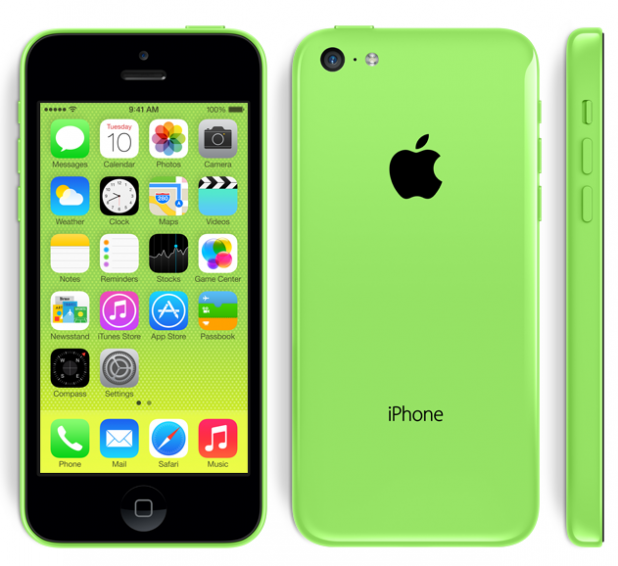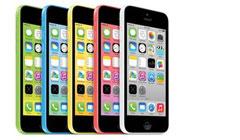 The plastic iPhone 5C.[/caption] Apple has unveiled a pair of new iPhones. Apple CEO Tim Cook took to a California stage Sept. 10 and, after a couple of brief updates on the iTunes Festival (now in its seventh year, this edition featuring musicians such as Justin Timberlake and Katy Perry) and the company’s retail operations, moved onto the meat of the unveiling event. The first big announcement: iOS 7 is nearing completion. Apple’s next generation of devices will come with iOS 7, a radical overhaul of the company’s longtime mobile operating system, which strips out many of the older versions’ graphical elements in favor of an ultra-colorful “flat” layout. While some have praised the new aesthetic as a much-needed upgrade to software that was beginning to show its age, others have denigrated the design as neon-hued spew. In addition to the visual updates, iOS 7 features a variety of software tweaks, including major revamps to the Notification Center and Control Center. Siri, the voice-activated digital assistant, can search Tweets, the Web, and other places for information. On top of that, iOS 7 includes iTunes Radio, a streaming service announced earlier this year. Apple is making a big bet that the Pandora-like program can take advantage of the rising interest in streaming services. If everything goes according to schedule, iOS 7 will arrive Sept. 18 as a free download. Cook also discussed iWork, the company’s suite of productivity apps, along with “creativity” apps such as iPhoto (all of it free with any new iOS device). Although the audience turned out for new iPhones, Apple clearly wanted to show that its in-house software is cutting-edge. Then came the iPhone portion of the program. The iPhone 5 is being replaced by two new smartphone designs.
The plastic iPhone 5C.[/caption] Apple has unveiled a pair of new iPhones. Apple CEO Tim Cook took to a California stage Sept. 10 and, after a couple of brief updates on the iTunes Festival (now in its seventh year, this edition featuring musicians such as Justin Timberlake and Katy Perry) and the company’s retail operations, moved onto the meat of the unveiling event. The first big announcement: iOS 7 is nearing completion. Apple’s next generation of devices will come with iOS 7, a radical overhaul of the company’s longtime mobile operating system, which strips out many of the older versions’ graphical elements in favor of an ultra-colorful “flat” layout. While some have praised the new aesthetic as a much-needed upgrade to software that was beginning to show its age, others have denigrated the design as neon-hued spew. In addition to the visual updates, iOS 7 features a variety of software tweaks, including major revamps to the Notification Center and Control Center. Siri, the voice-activated digital assistant, can search Tweets, the Web, and other places for information. On top of that, iOS 7 includes iTunes Radio, a streaming service announced earlier this year. Apple is making a big bet that the Pandora-like program can take advantage of the rising interest in streaming services. If everything goes according to schedule, iOS 7 will arrive Sept. 18 as a free download. Cook also discussed iWork, the company’s suite of productivity apps, along with “creativity” apps such as iPhoto (all of it free with any new iOS device). Although the audience turned out for new iPhones, Apple clearly wanted to show that its in-house software is cutting-edge. Then came the iPhone portion of the program. The iPhone 5 is being replaced by two new smartphone designs.
Apple Unveils iPhone 5C, iPhone 5S
[caption id="attachment_12228" align="aligncenter" width="618"]  The plastic iPhone 5C.[/caption] Apple has unveiled a pair of new iPhones. Apple CEO Tim Cook took to a California stage Sept. 10 and, after a couple of brief updates on the iTunes Festival (now in its seventh year, this edition featuring musicians such as Justin Timberlake and Katy Perry) and the company’s retail operations, moved onto the meat of the unveiling event. The first big announcement: iOS 7 is nearing completion. Apple’s next generation of devices will come with iOS 7, a radical overhaul of the company’s longtime mobile operating system, which strips out many of the older versions’ graphical elements in favor of an ultra-colorful “flat” layout. While some have praised the new aesthetic as a much-needed upgrade to software that was beginning to show its age, others have denigrated the design as neon-hued spew. In addition to the visual updates, iOS 7 features a variety of software tweaks, including major revamps to the Notification Center and Control Center. Siri, the voice-activated digital assistant, can search Tweets, the Web, and other places for information. On top of that, iOS 7 includes iTunes Radio, a streaming service announced earlier this year. Apple is making a big bet that the Pandora-like program can take advantage of the rising interest in streaming services. If everything goes according to schedule, iOS 7 will arrive Sept. 18 as a free download. Cook also discussed iWork, the company’s suite of productivity apps, along with “creativity” apps such as iPhoto (all of it free with any new iOS device). Although the audience turned out for new iPhones, Apple clearly wanted to show that its in-house software is cutting-edge. Then came the iPhone portion of the program. The iPhone 5 is being replaced by two new smartphone designs.
The plastic iPhone 5C.[/caption] Apple has unveiled a pair of new iPhones. Apple CEO Tim Cook took to a California stage Sept. 10 and, after a couple of brief updates on the iTunes Festival (now in its seventh year, this edition featuring musicians such as Justin Timberlake and Katy Perry) and the company’s retail operations, moved onto the meat of the unveiling event. The first big announcement: iOS 7 is nearing completion. Apple’s next generation of devices will come with iOS 7, a radical overhaul of the company’s longtime mobile operating system, which strips out many of the older versions’ graphical elements in favor of an ultra-colorful “flat” layout. While some have praised the new aesthetic as a much-needed upgrade to software that was beginning to show its age, others have denigrated the design as neon-hued spew. In addition to the visual updates, iOS 7 features a variety of software tweaks, including major revamps to the Notification Center and Control Center. Siri, the voice-activated digital assistant, can search Tweets, the Web, and other places for information. On top of that, iOS 7 includes iTunes Radio, a streaming service announced earlier this year. Apple is making a big bet that the Pandora-like program can take advantage of the rising interest in streaming services. If everything goes according to schedule, iOS 7 will arrive Sept. 18 as a free download. Cook also discussed iWork, the company’s suite of productivity apps, along with “creativity” apps such as iPhoto (all of it free with any new iOS device). Although the audience turned out for new iPhones, Apple clearly wanted to show that its in-house software is cutting-edge. Then came the iPhone portion of the program. The iPhone 5 is being replaced by two new smartphone designs.
 The plastic iPhone 5C.[/caption] Apple has unveiled a pair of new iPhones. Apple CEO Tim Cook took to a California stage Sept. 10 and, after a couple of brief updates on the iTunes Festival (now in its seventh year, this edition featuring musicians such as Justin Timberlake and Katy Perry) and the company’s retail operations, moved onto the meat of the unveiling event. The first big announcement: iOS 7 is nearing completion. Apple’s next generation of devices will come with iOS 7, a radical overhaul of the company’s longtime mobile operating system, which strips out many of the older versions’ graphical elements in favor of an ultra-colorful “flat” layout. While some have praised the new aesthetic as a much-needed upgrade to software that was beginning to show its age, others have denigrated the design as neon-hued spew. In addition to the visual updates, iOS 7 features a variety of software tweaks, including major revamps to the Notification Center and Control Center. Siri, the voice-activated digital assistant, can search Tweets, the Web, and other places for information. On top of that, iOS 7 includes iTunes Radio, a streaming service announced earlier this year. Apple is making a big bet that the Pandora-like program can take advantage of the rising interest in streaming services. If everything goes according to schedule, iOS 7 will arrive Sept. 18 as a free download. Cook also discussed iWork, the company’s suite of productivity apps, along with “creativity” apps such as iPhoto (all of it free with any new iOS device). Although the audience turned out for new iPhones, Apple clearly wanted to show that its in-house software is cutting-edge. Then came the iPhone portion of the program. The iPhone 5 is being replaced by two new smartphone designs.
The plastic iPhone 5C.[/caption] Apple has unveiled a pair of new iPhones. Apple CEO Tim Cook took to a California stage Sept. 10 and, after a couple of brief updates on the iTunes Festival (now in its seventh year, this edition featuring musicians such as Justin Timberlake and Katy Perry) and the company’s retail operations, moved onto the meat of the unveiling event. The first big announcement: iOS 7 is nearing completion. Apple’s next generation of devices will come with iOS 7, a radical overhaul of the company’s longtime mobile operating system, which strips out many of the older versions’ graphical elements in favor of an ultra-colorful “flat” layout. While some have praised the new aesthetic as a much-needed upgrade to software that was beginning to show its age, others have denigrated the design as neon-hued spew. In addition to the visual updates, iOS 7 features a variety of software tweaks, including major revamps to the Notification Center and Control Center. Siri, the voice-activated digital assistant, can search Tweets, the Web, and other places for information. On top of that, iOS 7 includes iTunes Radio, a streaming service announced earlier this year. Apple is making a big bet that the Pandora-like program can take advantage of the rising interest in streaming services. If everything goes according to schedule, iOS 7 will arrive Sept. 18 as a free download. Cook also discussed iWork, the company’s suite of productivity apps, along with “creativity” apps such as iPhoto (all of it free with any new iOS device). Although the audience turned out for new iPhones, Apple clearly wanted to show that its in-house software is cutting-edge. Then came the iPhone portion of the program. The iPhone 5 is being replaced by two new smartphone designs.
